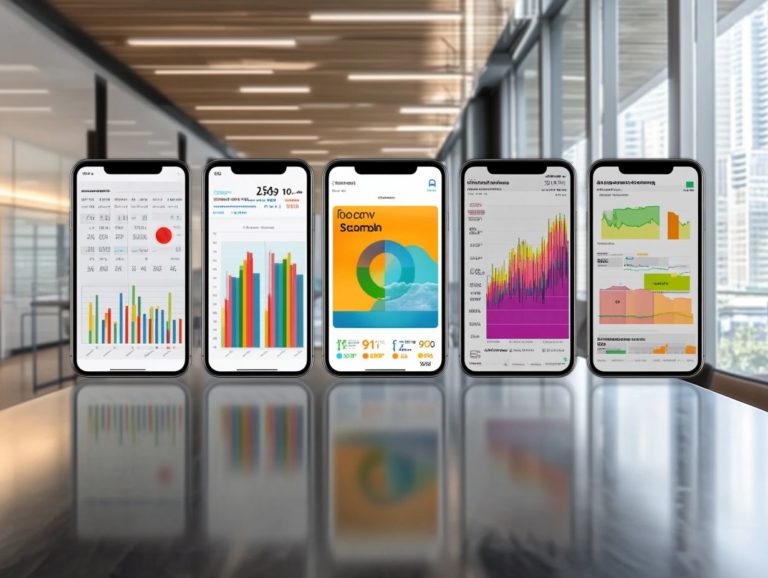Best Practices for Performance Metrics in Organizations
In today s fast-paced business landscape, grasping and adeptly employing performance metrics is essential for achieving success.
This article delves into the fundamental aspects of performance metrics, defining key performance indicators (KPIs) and outlining their advantages for decision-making and progress tracking.
It highlights the various metrics commonly utilized in organizations, ranging from sales and revenue to employee performance. You ll also discover best practices for implementing these metrics and the pitfalls to steer clear of, ensuring your organization flourishes through well-informed strategies.
Contents
- Key Takeaways:
- Understanding Performance Metrics
- Benefits of Using Performance Metrics
- Common Performance Metrics in Organizations
- Implementing Performance Metrics
- Challenges and Pitfalls to Avoid
- Frequently Asked Questions
- What are best practices for performance metrics in organizations?
- Why is it important to have performance metrics in organizations?
- How do you choose the right performance metrics for an organization?
- What are some common mistakes organizations make when using performance metrics?
- What is the role of leadership in implementing performance metrics in organizations?
- How can organizations ensure their performance metrics are effective?
Key Takeaways:

- Tracking progress and making informed decisions are crucial benefits of using performance metrics in organizations.
- Setting specific goals and establishing a system is key to successfully implementing performance metrics.
- Common mistakes can be avoided by understanding and defining key performance indicators, such as sales and revenue metrics and employee performance metrics.
Understanding Performance Metrics
Understanding performance metrics is essential for your organization to align your goals with real results. These metrics act as your compass, guiding HR leaders and management teams in evaluating employee engagement, assessing performance, and achieving goals.
By implementing a well-structured performance management strategy, which is a plan to improve how everyone works together effectively, you can elevate your overall performance. This insight enables effective feedback mechanisms, tailored performance evaluations, and continuous improvement initiatives elements that are vital for fostering a dynamic and thriving company culture.
Defining Key Performance Indicators (KPIs)
Key Performance Indicators (KPIs) are measurable values that reveal how effectively your organization is achieving its strategic objectives and performance goals.
These metrics are essential tools for performance assessment. They allow you to evaluate success in a structured way. By establishing clear KPIs, you ensure that all team members are aligned with the overarching mission, making it simpler to track progress over time. This alignment is particularly crucial for leadership teams, as it nurtures a culture of accountability and transparency.
For example, your company might use KPIs to monitor customer satisfaction scores or sales growth rates, giving you the power to make informed decisions during strategic planning sessions. Such practices enhance goal setting and drive continuous improvement across various departments, ultimately leading to greater overall success!
Benefits of Using Performance Metrics
Utilizing performance metrics can transform your decision-making and cultivate a culture of employee engagement within your organization. By adopting effective performance management strategies, you can meticulously track progress against strategic objectives and pinpoint areas ripe for improvement.
These metrics empower your teams to embrace continuous feedback, ensuring that coaching opportunities are seamlessly aligned with employees’ developmental needs. This alignment boosts individual growth and drives business success!
Improving Decision Making and Tracking Progress

Improving your decision-making through performance metrics is crucial for effective management strategies. Unlock your potential by tracking progress and adapting seamlessly to changing conditions.
By harnessing these metrics, you can gain valuable insights into how well your operations run and overall performance, leading to informed decisions that foster growth. Take Netflix, for example. They employ advanced data analysis to monitor viewer preferences and engagement, which in turn refines their content recommendations and original programming strategy.
This enables them to make adjustments that enhance service delivery. These immediate assessments not only facilitate agility in executing strategies but also empower you to align your objectives more closely with customer expectations, ultimately driving your success.
Common Performance Metrics in Organizations
Organizations often depend on a range of performance metrics to evaluate both sales and employee performance. This ensures that every effort aligns with their strategic objectives and operational goals.
Sales and Revenue Metrics
Sales and revenue metrics are essential indicators that enable you to assess your organization’s financial performance and strategic priorities.
They offer vital insights into key areas such as customer acquisition costs (the cost to gain a new customer), overall sales growth, and profit margins, all of which are crucial for making informed decisions. By diligently monitoring these metrics, you can spot trends, allocate resources wisely, and refine your strategies to enhance profitability.
Understanding metrics like customer lifetime value and conversion rates is essential for fine-tuning your sales processes. Ultimately, these quantitative measures act as benchmarks for performance management, steering you toward sustainable growth and a competitive edge in your market.
Employee Performance Metrics
Employee performance metrics are crucial for assessing your contributions, overall engagement, and the effectiveness of performance evaluations within your organization.
These metrics create a structured framework that allows you, as a leader, to monitor progress and pinpoint areas for improvement. This ensures that your efforts align with the organization s goals. When evaluating engagement, specific metrics such as productivity levels, quality of work, and collaboration rates engage you in your role.
Regular feedback amplifies the effectiveness of performance coaching by providing you with timely insights, fostering a culture of continuous improvement. Consistent feedback not only helps establish clear expectations but also motivates you, empowering you to take ownership of your performance journey.
Implementing Performance Metrics

To implement performance metrics effectively, you need a well-rounded method that not only sets clear goals but also aligns with your organizational performance management strategy. This alignment ensures that every metric serves a purpose and contributes to your broader objectives.
Setting Goals and Establishing a System
Setting clear goals and establishing a robust performance management system are essential for guiding your organization toward its strategic objectives.
This process starts with identifying specific, measurable, achievable, relevant, and time-bound objectives that resonate with the organization s vision. Leadership plays a pivotal role here; as a leader, it’s crucial to communicate these goals effectively to your teams, ensuring that everyone understands their individual contributions to collective success.
Regular feedback loops are vital in this context helpful feedback enables your employees to navigate challenges and stay aligned with the goals you’ve set. Fostering a culture of open communication empowers team members to share their concerns and ideas, enhancing collaboration and boosting performance throughout the organization.
Challenges and Pitfalls to Avoid
Understanding the challenges of performance management is essential for any organization. Recognizing these details positions your organization for meaningful growth and a thriving workplace culture.
Common Mistakes and Solutions
Common mistakes can hinder growth and employee development. Addressing these issues directly is vital.
Many overlook the importance of setting clear and measurable objectives. This can cause misunderstandings about expectations.
When feedback is lacking, team members may feel unsupported. This often leads to decreased motivation and productivity.
Performance reviews that are infrequent or poorly structured leave employees uncertain about their progress.
You can counteract these issues by implementing regular check-ins. These promote open dialogue and establish SMART goals specific, measurable, achievable, relevant, and time-bound.
Training managers on effective appraisal techniques creates an empowering atmosphere. This alignment connects individual contributions with the organization s vision.
Frequently Asked Questions

What are best practices for performance metrics in organizations?
Best practices involve setting clear and measurable goals, choosing relevant metrics, regularly tracking data, and using insights for decision-making and performance improvement.
Why is it important to have performance metrics in organizations?
Performance metrics measure success and help identify areas for improvement. They keep you on track toward your goals!
How do you choose the right performance metrics for an organization?
The right metrics align with organizational goals and should be specific, measurable, achievable, relevant, and time-bound. Get key stakeholders involved they can offer valuable insights!
What are some common mistakes organizations make when using performance metrics?
Common mistakes include choosing too many metrics, using irrelevant metrics, and not regularly reviewing them to reflect changing goals.
What is the role of leadership in implementing performance metrics in organizations?
Leadership sets a strong example by using metrics to guide decision-making and ensuring team members understand their importance in achieving organizational goals.
How can organizations ensure their performance metrics are effective?
To ensure effectiveness, regularly review and analyze data, communicate results to stakeholders, and use insights to make informed decisions and drive performance improvements.




